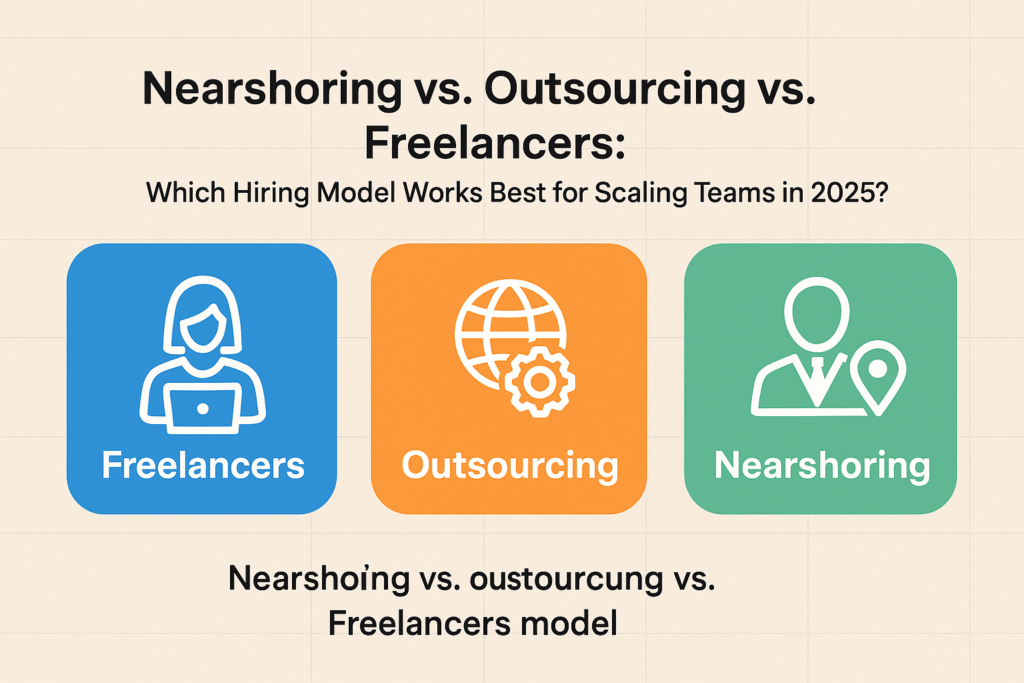Nearshoring vs. Outsourcing vs. Freelancers: Which Hiring Model Is Best for Scaling in 2025?

Scaling a business in today’s market is no simple task. Talent shortages in Europe and North America, coupled with rising recruitment costs, have made it increasingly difficult for companies to expand their teams efficiently. Business leaders are asking an important question: Which hiring strategy makes the most sense — nearshoring, outsourcing, or freelancers?
Each model comes with distinct advantages and limitations. Understanding the differences is crucial for selecting the most effective approach to achieve long-term growth.
Freelancers: Flexible but Limited
Freelancers have become an accessible option for companies of all sizes, thanks to platforms such as Upwork, Fiverr, and Toptal. Hiring independent professionals allows businesses to quickly fill skill gaps or complete specific projects without committing to full-time staff.
This approach offers flexibility, low upfront costs, and immediate access to global talent. However, freelancers are rarely a long-term solution. Quality can vary, accountability is often limited, and freelancers are typically not invested in a company’s long-term success. They work best for short-term assignments or highly specialized tasks rather than as part of a scalable growth strategy.
Outsourcing: Cost Savings with Reduced Control
Outsourcing involves contracting an external company to manage certain business functions, whether it’s IT support, customer service, or software development. This model can reduce costs significantly compared to hiring locally and often provides access to established processes and infrastructure.
The trade-off is reduced control. Time zone differences, cultural gaps, and communication challenges can create barriers, and businesses may feel disconnected from the teams handling their critical operations. Outsourcing is well-suited for non-core functions but is less effective when companies want direct oversight or seamless integration with in-house teams.
Nearshoring: Cost Efficiency and Team Integration
Nearshoring has emerged as a middle ground between freelancers and outsourcing. In this model, companies partner with service providers in nearby regions — for example, European and North American companies often turn to the Balkans.
The benefits are clear. Nearshoring offers significant cost savings (typically 30–40% compared to local hiring), shorter hiring timelines, and access to pre-vetted talent pools. Because teams are based in geographically closer regions, there is greater cultural alignment, overlapping working hours, and smoother communication.
Unlike outsourcing, nearshoring allows companies to build dedicated, full-time teams that operate as an extension of their organization. With the right partner, payroll, compliance, and HR management are handled on behalf of the client, reducing administrative pressure and ensuring long-term team stability.
| Factor | Freelancers | Outsourcing | Nearshoring (Balkan Model) |
|---|---|---|---|
| Cost | Low per project | Lower than local hiring | 30–40% savings long-term |
| Time-to-Hire | Immediate | 2–3 months | 2–4 weeks |
| Commitment | Short-term | Medium-term | Long-term, permanent |
| Control | High but limited in scope | Low (provider-controlled) | High (shared management) |
| Integration | Minimal | Limited | Full integration possible |
| Scalability | Poor | Moderate | Excellent |
This comparison makes it clear: while freelancers and outsourcing can meet certain needs, nearshoring provides the balance of cost efficiency, quality, and long-term scalability that most growing companies require.
Choosing the Right Model
The best hiring strategy depends on the goals of your business:
- Freelancers are ideal for quick, specialized projects where flexibility matters more than integration.
- Outsourcing works for companies looking to cut costs on non-core functions, but who are comfortable sacrificing some control.
- Nearshoring is the most effective option for organizations that want to scale sustainably. It combines cost savings with long-term team stability and provides full integration into daily operations.
For companies struggling with lengthy recruitment processes, high turnover, or stretched HR resources, nearshoring is increasingly the preferred choice.
Conclusion
In 2025, businesses cannot afford inefficiencies in recruitment. Hiring models that once worked are proving too slow or too costly to keep up with demand. Freelancers and outsourcing offer short-term solutions, but nearshoring stands out as the most practical path for scaling teams quickly and cost-effectively.
By partnering with a provider like Advantcode, companies can reduce hiring costs by up to 40%, access top Balkan talent within weeks, and rely on comprehensive HR, payroll, and compliance support. The result is a scalable, reliable, and stress-free hiring process that fuels long-term growth.
